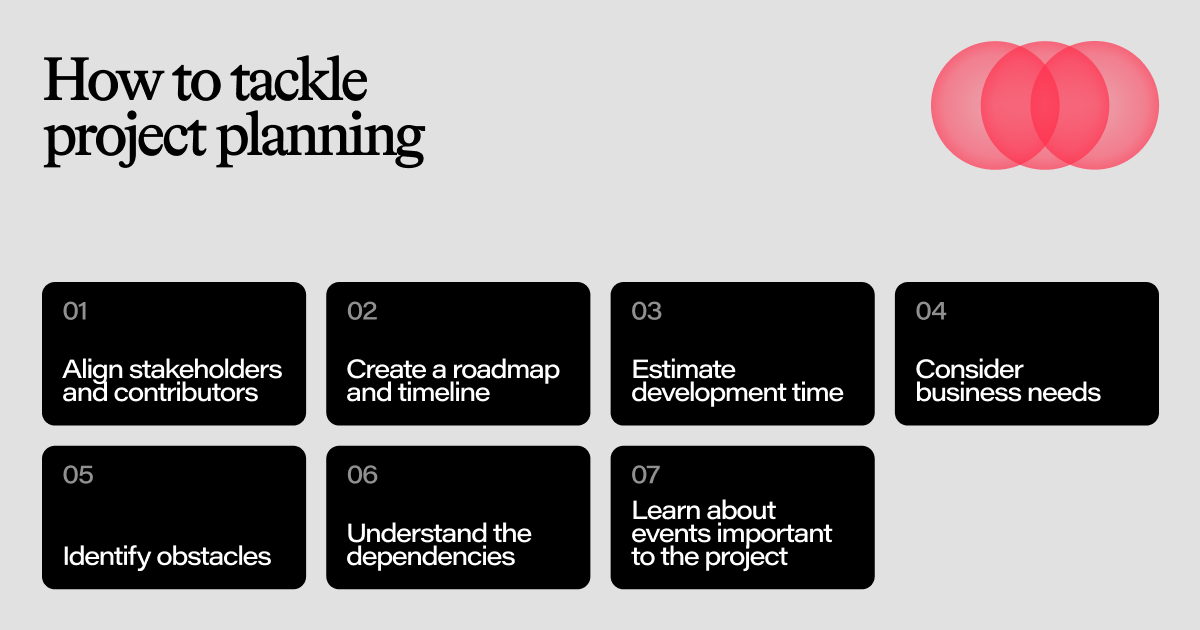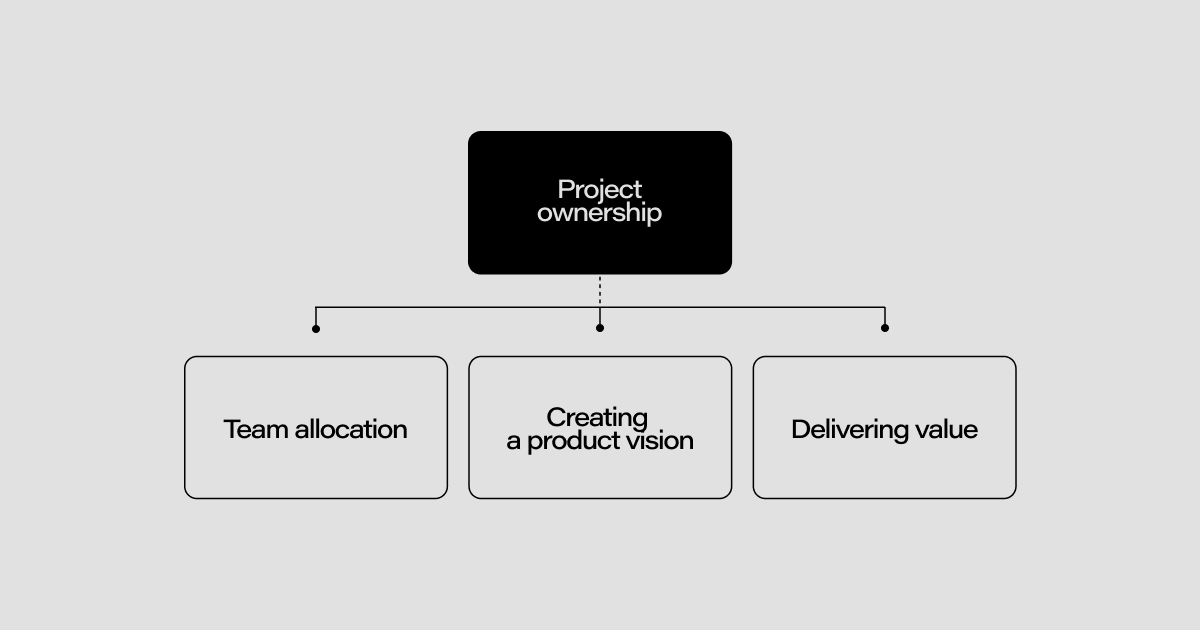IoT project management can be a wild ride filled with unique challenges and exciting opportunities. As PMs, our role extends beyond traditional project management elements like scope, time, cost, and quality – it’s also about managing interdisciplinary teams with software, firmware, and hardware expertise, and dealing with specific IoT risks such as outdated technology, security, and compatibility.
In the first part of this series of articles, we're going to dive into some significant topics you need to know to make your project a success. Here, we’ll talk in-depth about project planning and establishing a clear vision for it, highlighting the project management areas specific to IoT. Ready? Let's jump in!
Ensuring realistic project planning
Accurate project planning is one of the critical pillars determining a project's success. A PM’s first responsibility is to set the project's foundation. Here are some important considerations for project planning:

1. Align stakeholders and contributors at the beginning
One of the first steps in realistic project planning is ensuring that all stakeholders and contributors are on the same page from the start. You must facilitate their understanding of their roles, expectations, and how their contributions impact results.
2. Create a sensible roadmap and timeline
A well-defined roadmap and timeline are crucial for maintaining focus and tracking progress. This should include all major tasks, milestones, and deadlines, factoring in any key dates from the client. Ideally, you should establish the roadmap's initial version as soon as possible after the project starts, for instance, after the kick-off workshop.
3. Estimate development time realistically
While estimating, whether during sprint planning or in a Kanban setup, it's crucial the team accounts for the actual number of working hours in a week. This includes carving out time for meetings and personal development - they're part of the game too. And once the developers finish their estimates, make sure to have a chat with QA. Their unique perspective can often shed new light on these timeframes.
Considerations specific to IoT

Specifically estimate hardware, firmware, and software development time. IoT projects often involve hardware, firmware, and software development with significantly different timelines and dependencies. A PM is responsible for gathering separate estimates for each component and integrating them into the project plan.
Consider hardware prototyping and manufacturing. IoT can involve hardware prototyping and manufacturing, which add another layer of complexity to project planning. Take into account the time and cost associated with designing, prototyping, testing, and manufacturing IoT devices.
4. Consider business needs, technical possibilities, and constraints
Realistic project planning requires an understanding of the business needs the project aims to address and the technical possibilities and constraints. What does the client want to achieve with this project? What is the prime value for end users? What technologies can be used to realize these goals? What are the limitations or constraints that might hinder progress? These are all crucial questions that need to be answered during the planning stage.
Considerations specific to IoT

Think about network availability and performance. IoT devices rely on network connectivity. Considerations related to the choice of technology, the availability of network infrastructure, and the network's performance characteristics should be incorporated into project planning.
Security and Privacy. IoT projects have unique security and privacy considerations due to the data they collect and process. Include time in the project plan for security and privacy assessments and the implementation of necessary security measures.
Regulatory compliance. Depending on the nature of the IoT device and its use, there may be regulatory compliance issues to consider (e.g., FCC for radio-frequency devices in the US). Plan time for understanding and complying with these regulations.
5. Identify and mitigate obstacles, risks, or red flags
A Project Manager’s role involves identifying potential obstacles, risks, or red flags that might disrupt your project's timeline or deliverables. Regular risk assessments throughout the project will help you keep these issues in check and make necessary adjustments as needed.
6. Understand the dependencies
Recognizing the dependencies, not only within your project tasks but also with third-party teams, is vital. This will help you prioritize tasks, allocate resources efficiently, and ensure a smoother workflow.
Considerations specific to IoT

Interoperability and standards. IoT projects often require integration with other devices and systems, making interoperability a key consideration. Consider the time and resources needed to ensure compliance with relevant IoT standards and protocols.
Continuous updates and maintenance. IoT devices often require continuous updates to ensure security and performance, which you should factor into the project plan.
Access to the necessary hardware. IoT projects may need special hardware - you must ensure the team members have the necessary resources to work effectively and efficiently. Take into account the time needed for the devices’ shipment and delivery.
7. Learn about investment rounds, product demos, beta testing, events, etc.,
…and where they fit on the roadmap. This ensures that all project activities are aligned with these events, providing seamless integration and avoiding conflicts.
Establish Project Ownership and Vision
In addition to realistic project planning, establishing project ownership and a shared vision is pivotal to driving a project toward success. In the context of IoT, this involves considering the project's interdisciplinary nature and understanding the IoT ecosystem. Here's how to go about it:

1. Navigate through team allocation and resource gaps
As the Project Manager, you are the glue that holds all project aspects together. It is your responsibility to ensure that all roles in the project are clearly defined and filled. If there are gaps, it's your task to fill them - by assigning tasks to existing team members or flagging the need for new recruits on the #planning channel. Either way, your aim to fill in any gaps to ensure your project runs smoothly from start to finish.
Considerations specific to IoT

Interdisciplinary nature of IoT. The projects often require an interdisciplinary approach involving knowledge in areas like hardware, firmware and software development, data analytics, and network communications. Emphasize the need to clearly define and fill roles across these areas.
2. Support the Product Owner in creating a product vision
A clear product vision is a guiding star for any project. Supporting the Product Owner in crafting this vision is critical. Using the "Think Partner" approach, which emphasizes collaboration and open communication, you can help guide the development of a vision that aligns with both the business goals and the user needs. This ensures the project direction is clear, shared, and inspiring for everyone involved.
Considerations specific to IoT

Understand and convey the IoT ecosystem. Part of creating a clear product vision for an IoT project is understanding and conveying the IoT ecosystem in which the product will operate. This includes other devices, networks, and data systems with which it will interact.
3. Focus on delivering value
The ultimate measure of a project's success is the value it delivers to stakeholders. Here are a few ways to ensure that your project is value-focused:
Identify valuable features. Spend time identifying the features that will provide the most value to end-users and stakeholders. In the case of IoT, this might include features that enhance security, reliability, and user experience across multiple devices and interfaces.
Value delivery. Every sprint counts. Ditch the idea of a "setup" sprint (or “sprint 0”) and focus on delivering working functionality right out of the gate. Make sure you're measuring the value you're delivering. Tools like Earned Value Analysis (more in this article: Earned Value Analysis) can help keep you on track.
Identify value beyond development. A Project isn't confined only to product development. It could also lie in areas like dependency tracking, user research, or help with demo assets.
For IoT projects, this may also include setting up or managing the IoT infrastructure, such as networks, cloud services, and data storage systems. Look for ways to deliver value outside of development and fill in these blanks. This holistic approach to value can lead to better project outcomes and higher stakeholder satisfaction.
Summary
To sum it up, realistic project planning is all about meticulous preparation, close collaboration, and proactive risk management. Keep these points in mind to ensure a smooth and successful project journey.
By combining strong ownership with a shared vision and a focus on delivering value, you can guide your project team toward a successful outcome that meets or even exceeds stakeholder expectations.
Looking for a team to manage your IoT project? Don't hesitate to get in touch!

Agnieszka Bursztynowska
Senior Project Manager

